| Interior
Location - Ti's Hall Tatemachi, Kanazawa, Japan 8th - 17th October 2004
Installation Notebook Location information (Japanese only)
|
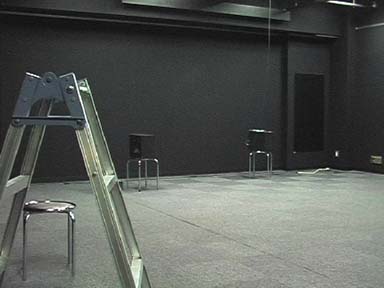 |
Monday 18 October 2004
The installation is de-installed. Many thanks to Horita from Ti's Hall who was constantly helpful and supportive. And to the exhibition organisers, Another Movement, and especially to the visitors to the installation without whom...
Saturday 16 October 2004
| A repeat performance at Korinbo
Harbor in front of about 50 people
for Rirkrit Tiravanija's International Cooking Party. Afterwards
the students tried to teach me how to play a 3 stringed instrument from
Okinawa. I failed the traditional stuff, but nearly managed The
Flintstones
theme tune. |
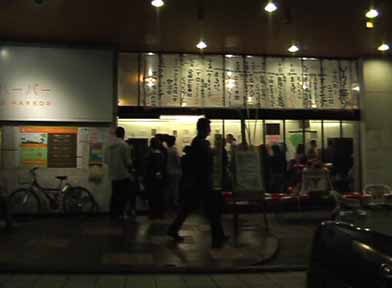 |
A holiday weekend, Kanazawa is full of tourists and visitors to the Museum - a by-product of this is a steady stream of visitors to my installation over the weekend. They drift up the stairs individually or in clusters of (for some reason) never more than four. This turns out to be quite a good number of people to be in the space, makes the installation quite active and variable.
Saturday had a very strange atmosphere, the effect of low pressure from the typhoon (Kanazawa wasn't in the main path this time, so a bit of rain, nothing dramatic). Since then the installation seems to have matured, developed a richer harmonic content. This has happened before when an installation has been running for a while - I used to assume it was because the set up process deafened me sufficiently to only become aware of this after a few days but recordings suggest otherwise. It could be a side-effect of breaking in new loudspeakers, this happened about the same time last year with the Ikon installation which was mostly new speakers.
In the early evening I performed at Korinbo Harbor, a student-run café initiated as a Rirkrit Tiravanija project. Playing guitar into a series of delays of between 12 and 26 seconds producing a long ambient atmosphere. My procedure was to play for maybe 10 minutes, leave the performance area with the permutations of delays cycling for maybe 20 minutes and then return to remove some elements and add others. Unlike, for instance, the On Kawara performance in 2002 where I played something similar but stayed in position for two hours, listening a lot but playing very little. For some people that created an uncomfortable expectation - why is he sitting there apparently doing nothing? Here, the scale of the event helped, all contact with the audience was close and direct, expectations were different - people switched easily between watching and listening and having conversations and eating. Even some dancing. Different levels of attention, as I was hoping, and making more sense within a Rirkrit project than I had anticipated. His all-embracing unmatrixed work worried me - that the structures were too simplistic to have an art function - to shift our observation or expectation, but recently I started thinking that his projects somehow have self-regulating structures built-in - that's why they work. I still can't figure out how...
One of the key student organisers was off sick and the amp and speakers I was hoping for were not there so I couldn't bounce the sound around the space as I was hoping. Nor was there anyone with a functional command of English. I plugged into a very small amplifier, usually used to play the radio in the kitchen. This turned out not to be a disadvantage, my intention was to play quietly in the background and the lack of available volume kept this under control, below the level of conversation. There was no soundcheck because of a minor crisis when I was setting up - the students produced a mains extension cable which we didn't know had a short in it. We plugged in and the power went off, equipment, fridge, till, coffee machine. Much confusion. About 15 people were coming in so the coffee was a priority. The quick way to learn the Japanese for fuse-box.
A lot of the music reminded me of the installation down the road, slow cycles of notes with no attack - partly through contingency, I was initially playing like this to moderate my volume level. The 'performance' lasted over 4 hours, many smiles and compliments afterwards.
Thursday 7 October 2004
Installation is stable. Running for about two hours the tendency towards stasis has not recurred this morning. I'm still not 100% happy with the lighting. One corner of the space is too dark.
In the absence of a spectator the cycles of the two feedback systems move in and out of phase. At certain points the whole installation will be silent for a moment. The cycles affect each other - a typical example: if system A is at the quiet point in the cycle system B will hold its note for longer than usual - this then affects system A which may become louder or longer for a cycle. The whole installation is interdependent and irregular (but stable). System A (blue on the diagram) is slightly dominant. In its absence system B will not feed back.
Later, some more recording of the empty space, cleaning and putting up signs. Opening tomorrow and a reception on Saturday. The information booths for the reception are in the garden of the new Museum and the exhibition organisers are worried that the approaching typhoon will disrupt events.
Wednesday 6 October 2004
The space is closed on Wednesdays.
Tuesday 5 October 2004
| Yesterday's settings are stable
and with a little fine tuning the room is set. Next, fixing and tidying wiring, then some experiments with lighting. Horita set up the stage lights used for events in the space. Looks impressive but the fan in the dimmer unit makes a lot of noise. There is a drink vending machine in the corridor outside which often makes a lot of noise but that is definitely perceived as outside the space and doesn't have an effect on the sound of the space. The lighting unit has a presence which is acoustically part of the space. |
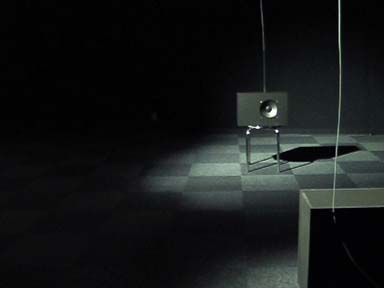 |
The rule in previous installations has been to light as brightly as possible, to reveal the space as simply as possible and remove any pseudo-mystic connotations. So back to the main lights. I switched off the lights nearest the entrance to the space as a compromise - this may succeed in drawing the spectator into the space, towards the brighter area.
16.00 and the installation is set. Off to a meeting of the exhibition organisers. Catalogues are collated and packed. Important issues are discussed in Japanese. Like how much to charge for the exhibition T shirt.
Monday 4 October 2004
| Ti's Hall is a small upstairs
space on the shopping street of Tatemachi, variously used for
projections, installations, dance events and so on. From my
limited experience of Japanese venues it's actually quite large.
That's why there are amplifiers and a mixer in the projection
booth/mixing room area. Downstairs is an internet café (without any coffee). The feel of the place is a slightly upmarket and very restrained version of what Strike, Stalk and Public Life tried and occasionally succeeded in bringing together in London's Spitalfields area. Today's new mic positions are a significant improvement, bringing out room harmonics in a very gentle bell-like way. Double system interaction is minimal, the two systems seem to work around each other and if uninterrupted (by the presence of someone in the space) they progress through a slow phase cycle lasting maybe 5/6 minutes. Speakers are behaving well. Fine tuning continues. The two systems are now sounding individually stronger, harmonically interdependent, the phase cycle tending to move towards unison when the room is empty. In relative terms - harmonic interdependence is fast time, phase cycles are slow time. |
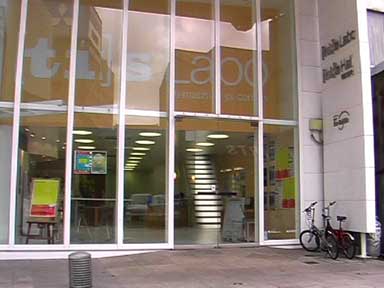 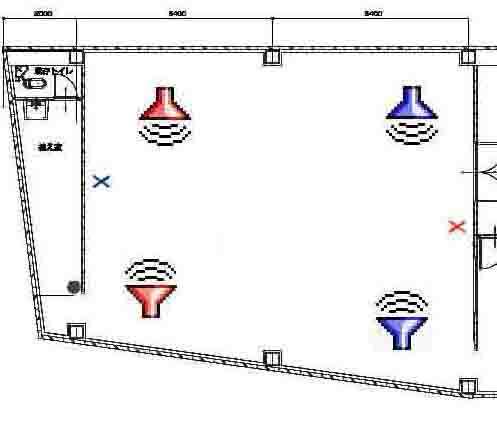 |
| Sunday 3 October 2004 An initial wait to let the system settle after switching on. The first change is to yesterday's very rough positioning is to move the speakers around. The bounce from the walls was not very productive in the way I has initially placed speakers so the placement now centres on using the volume of the space and letting any wall reflections be incidental. Because of the size of the room the presence of a spectator or myself can cause major shifts in the feedback pattern. The continuous wall surface is broken by a beam down the middle. Initially both mics were in the centre of the half of each wall nearest the entrance but now it's sounding more interesting with placement as in diagram (x = microphone). |
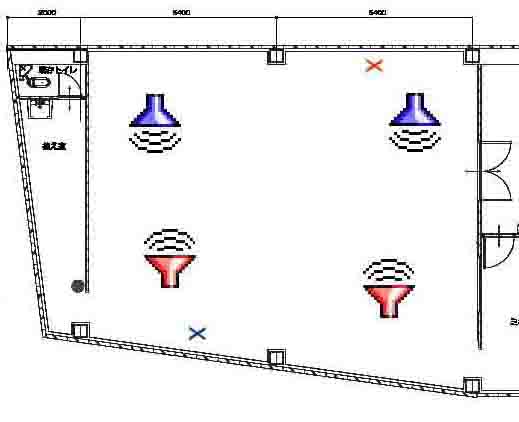 |
Next thing is to move the mics around to explore different possibilities in the space.
| Saturday 2 October 2004 Installation begins. Horita showed me around the space and the technical stuff, then I begin. Today is mostly connecting things, running cables and setting up amps and speakers. The speakers are on stools in the space, cables hung from the ceiling. By around 16.00 everything is up and running. The microphones are on opposing walls, each sending an output to the speakers facing the opposite wall. It works but could be better. Plenty of experimenting with the positioning of mics and
speakers to do. |
 |
Thursday 30 September 2004
Typhoon 21 has passed overnight relatively uneventfully in this area. By 09.45 blue sky is appearing.
Wednesday 29 September 2004
Typhoon 21 is moving in. Rain.
Monday 27 September 2004
The soundscape or aural culture of Kanazawa is not as traditional as
the guidebook suggests. A highlight is the
traffic light pedestrian crossing indicators, a bip-bop sound (for the
north-south axis, as far as I can work out)
and a sort of one note bird call for the cross streets. And a
combination for that great Japanese innovation, the diagonal pedestrian
crossing at busy junctions. Yesterday I heard two brass bands
playing outdoors.
In
Tatemachi, the shopping street where the installation will be located,
there is a night culture of singer-songwiters who perform with guitar
and small PA systems to a small but highly appreciative audience seated
on the street. On busy shopping days the street has amplified
music (usually
some sort of western folk-rock genre) from speakers built into
bollards which mixes into a horrible soup with the more upbeat output
from the boutiques.
Sunday 26 September 2004
A visit to the new 21st Century Museum of Contemporary Art in
Kanazawa. Large and impressive. Then a visit to Ti's Hall,
the space I will be using for the installation. Once again very
helpful and friendly people and what I hope will be a straightforward
installation process. Only problem at the moment is an extremely
noisy air conditioning in the space. There is talk of switching
it off and leaving the doors open which is both simple and makes the
space less exclusive or the outside world, more open to the spectator.
Let's hope there's not a noise problem with my sound leaking out
and bothering people.
Lunch at the seaside with Carsten Holler, Shugo from Shugoarts and
Mr Washita from the Kanazawa Museum.
Saturday 25 September 2004
Arrival in Kanazawa.Friday 24 September 2004
A noise gate borrowed from ICC is arriving today. Visit to
Aoyama, CAY space to check out the practicalities for next month's
performance. A fairly intimate restaurant space with friendly and
helpful staff, probably the best situation I could hope for outside a
gallery.
|
Thursday 23 September 2004 Saitama. The exhibition organisers have a sponsorship arrangement with a mobile phone company which requires the artists to make a 30 second video to do with their work. So off to the park to make a video with a vague idea of pointing the camera at a tree and later adding a very short text about natural complexity, edited or re-written from the text Listening and The Listening Room. The park is full of beautiful trees and as I'm trying to decide which one to choose a large flock of pigeons start zooming around in the immediate area. This brings to mind Alvin Lucier's differentiation between the structures he uses and indeterminacy and chance procedures. So a quick pigeon video and a little http page about non-intentionality to clarify.Speaker construction and painting finished tonight. |
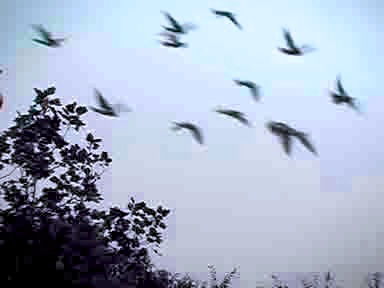 |
|
Wednesday 22 September 2004 Speaker construction continues. Saturday 18 September 2004 |
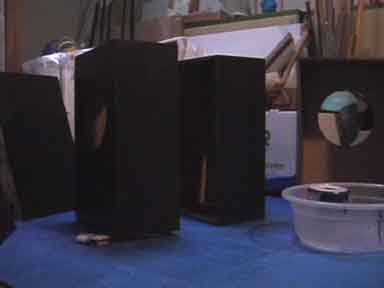 |
In Saitama, just outside Tokyo. After tests in London, some ideas about using speakers without enclosures proved hopeless. Today's task is to order up wood to size and start building speakers for the installation. Unlike the London equivalent, Tokyo has places which will do this in a very user-friendly way. Then a visit to Minoru Hatanaka at ICC.
return to:
Interior
Installations
Activated Space